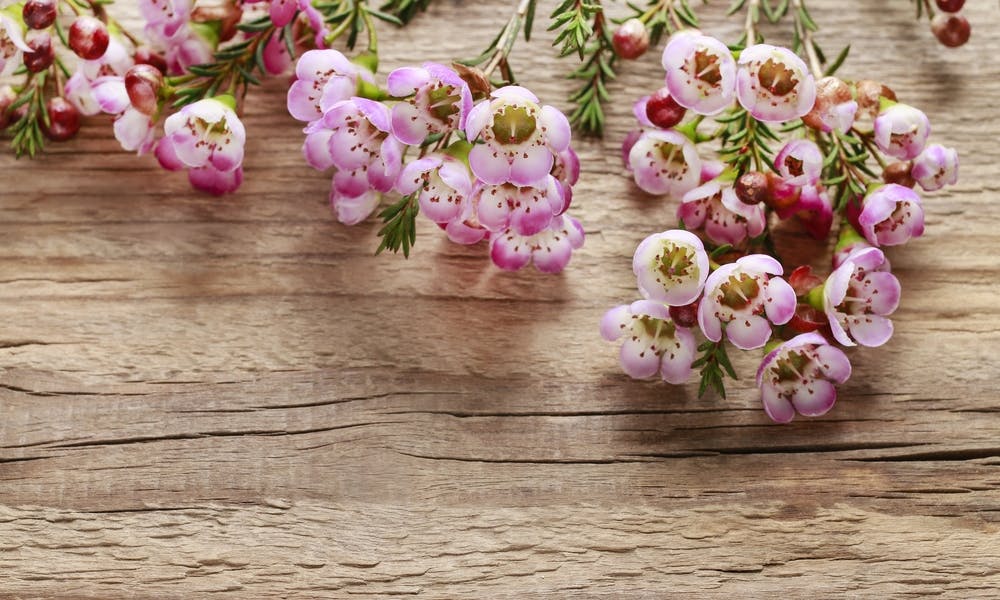MENU
The Wax Flower

One of Australia’s most popular flowers, the wax flower is a mainstay at weddings and celebrations across the country. From bouquets to vases, this beautiful flowering plant is another one of nature’s gifts. Since its discovery in the 19th century, it has become widely cultivated and is still going strong with its delicate, lovely petals wooing all those who catch sight of them. We delve into its history, symbolism in mainstream culture, and other fun facts.
Keep on reading to find out:
- History of the Wax Flower
- Flower Specs
- Symbolism in Culture
- Growing Your Own
- Care and Pruning
- How to Use the Cut Flowers
History of the Wax Flower
The wax flower, also known by its name chamelaucium Uncinatum, is a native flowering plant found in parts of Asia and Australia. It is part of the Myrtaceae, or myrtle family, alongside other plants such as the clove and eucalyptus flowers. The plant is related to tea trees such as leptospermum and thryptomene. A French botanist by the name of Rene Louiche Defontaines was the first to name the genus in 1819. As of now, there are close to 15 species in the genus. They tend to be found near the coastline, growing on sand or outcrops of granite. The Geraldton wax flower is considered the most popular due to its wide, showy petals and beautiful shape, with its name stemming from its supposed place of origin, which is the town of Geraldton in Australia. It commonly blooms within the summer and autumn months.
Flower Specs
A perennial plant, the wax flower is a woody evergreen typically found in small shrubs. It can grow anywhere from 6 inches to 10 feet high. The plant has relatively small leaves, opposite in shape and somewhat pointy. As its name suggests, the plants’ leaves and stem have a wax-like feel to them. Most of the species have 10 stamens, with five arching petals. The petals are shaped in an umbel cluster, which means that the stalks of the plant form up into a central point and create a flat, curved area. It bears somewhat shell-like fruit, with a tough exterior. The wax flowers produce a large quantity of oil from their glands and are quite fragrant, giving off a citrusy-lemon scent when they are crushed. Colors can range from white to pink, and even purple.
Symbolism in Culture
Within Australia, the wax flower is commonly used in wedding bouquets as a symbol of good fortune, happiness, and long-lasting love. Commercially it is wildly successful within Australia, with it being sold since the 1940s, and becoming the largest exported cut wildflower because of its tough and long-lasting nature. Alongside the Geraldton variety, a newer cultivar known as the pearl flower has been gaining popularity. The name chamelaucium is thought to stem from the old Greek words white dwarf, which refers to the plants’ small size and typically white-colored petals. Uncinatum refers to its hooked shaped leaves.
Growing Your Own
The wax flower is a bit of a stickler for dryer climates, requiring well-drained soil and lots of sunlight. They can do well in areas hit by drought, being able to survive long periods without water. Watering during initial planting is recommended, but intermittent watering after that is fine. Most of the soil wax flowers thrive in is relatively low quality, so utilizing any fertilizers can be counterproductive to the growth of the plant. Adding in some sand can benefit the plant as well. The seeds are quite difficult to germinate, so many gardeners use cuttings to propagate the plant more easily. With companies growing large quantities for commercial use in places as far as Israel, areas of Thailand, California, and even in Peru, you can be assured that they can be grown anywhere in the world.
Care and Pruning
The wax flower requires only a light pruning now and then. The stems require secateurs for cutting due to their thickness and tough exterior. Once they have been cut back slightly after blooming, the plants are forced to compress more, which helps keep the center of the plant open to receive more sunlight and fresh air. It is quite resistant to pests and diseases so not much to worry about there. Putting some organic mulch around the roots can help protect it from frost and stop weeds from taking root as well. If you happen to live in a more subtropical environment, be wary because although it can survive, high humidity levels can cause significant damage to the plant. If you are potting the plant, using support to help keep them upright may be necessary as they can get quite top-heavy.
How to Use the Cut Flowers
Most cuttings from the wax flower can be found between November up until April. Once cutting has been done, the flowers can be placed in vases, with water being changed after two to three days. The cut flowers generally last anywhere from eight to 10 days. Being long-lasting and quite durable, the wax flower has a host of uses at events such as in corsages, embellishments within cakes, tucked into napkins at parties, or simply left on the table to provide a lovely fragrance. When used in bouquets, as well as centerpieces or floral headpieces, it is commonly tied with tulips to create a beautiful effect.
The Lovely Wax Flower
With Australia’s infatuation of wax flowers not slowing down anytime soon, expect to see this flower growing in homes and gardens into the far future. From beautiful bridal bouquets to floral crowns, the lovely wax flower is a perfect addition to any event. Its delicate, heady fragrance just hooks its teeth into you and leaves you craving for more, so don’t miss out on another one of nature’s great creations!

